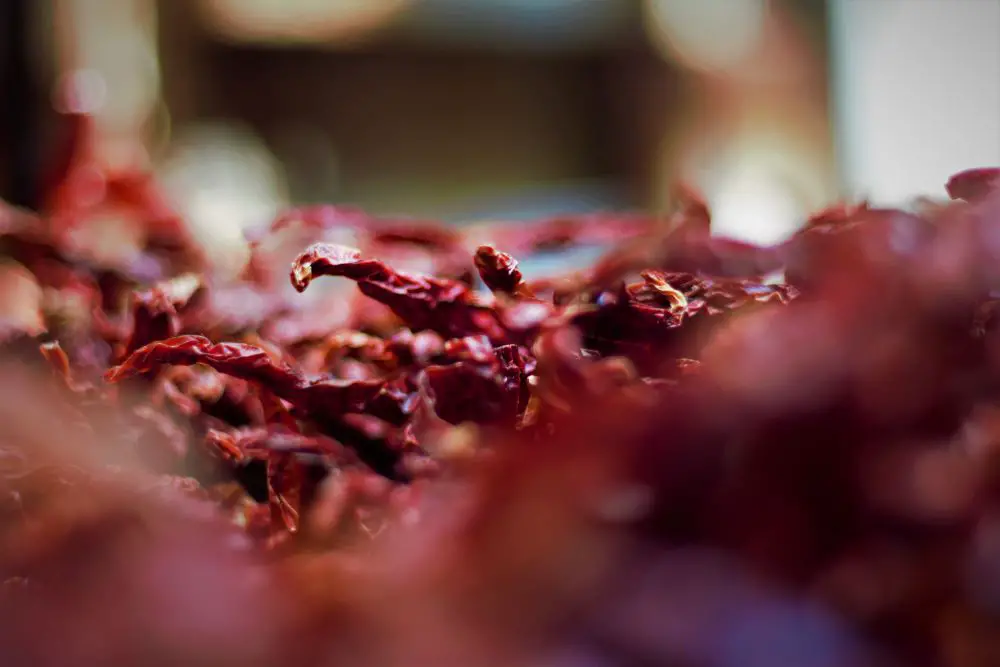Best Dehydrators for Off-Grid?
Preserving food is often a crucial part of living off-grid. It allows you to make the most of your food throughout the year. Canning and jarring are familiar ways of doing this, but dehydration is another option. Dehydrated food is packed with flavor, retains more beneficial nutrients and is less bulky to store.
Table of Contents
What is Dehydration?
Dehydration is a method of preserving food. The process of dehydrating food to preserve it works by combining two essential factors. The first is to use a very low heat over an extended period of time. Vitally, this is combined with the second essential factor, that of a steady flow of air to remove the moisture that evaporates from the food as it is heated. Removing the moisture from the food stops bacteria, mold and yeast from developing, which would cause the food to spoil.
Why Dehydrate When Living Off-Grid?
Dehydration works as a method for preserving food whether you live on or off the grid. However, it has some features that are worth taking advantage of for off-grid living:
Less waste by preserving food
It is likely that you are growing some of your own food if you are off-grid. Dehydrating gives you the chance to make use of your harvests for a lot longer period than the few weeks you can pick fresh. It also prevents you from getting fed up with having the same food for every meal in those few weeks!
An extra option for preserving food in addition to jarring
The dehydration process gives you the opportunity of preserving a whole range of foods and the results are different from those achieved through jarring or canning food.
Low cost
The main cost of dehydrating food is the cost of the dehydrator itself and as you will see later, this isn’t always necessary and needn’t be expensive.
Weight and space saving
Once food is dehydrated, it weighs very little and compacts down if stored well. This is especially great if you are not only living off-grid and perhaps storing a lot of food you have grown but also if space is at a premium in your RV or boat.
Low power
Most dehydrators are fairly low on their power consumption and so can be a good option when you are operating on alternative power off-grid. The only thing to remember is that you are likely to have them running for hours at a time so it helps of you have a steady supply of power rather than relying just on stored power.
Is Dehydrating Better Than Canning?
Possibly the most significant advantage dehydrating has over canning is space. Dried food takes up a lot less room to store than canned food and it is lighter in weight too. This may not be an issue if you have plenty of good storage space, but it could be a significant factor if space is an issue.
Dehydrating also preserves more of the nutritional value of food compared with canning. This is because it is only the moisture that is removed from the food during dehydration rather than the food being cooked.
Canning may be a better option for you if you are reliant on stored power. Although a dehydrator uses a fairly low amount of power, that draw is spread over a long time. If you have a steady supply of power like all year round solar it’ll be fine but if you don’t get much sun and are relying on stored power you might want to stick to canning. Although canning doesn’t use electricity it does require sustained heating from a stove which will still cost money.
Otherwise, the choice between dehydrating and canning food really comes down to taste. Many people will use both processes and develop a preference for preserving particular foods with each method.
What to Dehydrate
Knowing what you can preserve by dehydration is key to dehydrating successfully.

Good foods to dehydrate are:
- fruits
- vegetables
- beans
- lentils
- grains
- rice
- pasta
- low-fat meats
- seafood
- herbs
- sauces
Some foods don’t dehydrate well. These are mainly things that are high in fat. Fats do not evaporate, so an element of moisture will always stay in the food, causing it to spoil.
Foods that DO NOT dehydrate well are:
- nut butters
- avocado
- olives
- dairy products
- eggs are also not suitable for dehydration because of the high risk of salmonella.
Tips for Successfully Dehydrating Food
Different foods need different temperatures and different lengths of time at which to preserve food best. This is to remove the varying amounts of moisture at the optimum level. Just turning the heat up or leaving them in for longer does not work.
A few examples of the best temperatures are:
- 95°F for herbs
- 125°F for vegetables, beans and lentils
- 135°F for fruit
- 145°F for grains
- 145°F for pre-cooked meats
- 160°F for meat and seafood
- 165°F for poultry
- When dehydrating in batches, cut everything into uniform pieces, so they all dehydrate at the same rate. Invest in a mandolin if you are going to be doing a lot, as this will make life a whole lot easier!
- Some foods might benefit from pre-treating. This is particularly the case for fruits and vegetables. Vegetables benefit from being steamed or blanched before dehydrating. Fruits can be soaked in an ascorbic acid solution or a fruit juice high in citric acid e.g. lemon or lime juice, for about five minutes. Both these methods help to preserve color, prevent browning and retain flavor.
Tips for Successfully Storing your Dehydrated Food
While getting the dehydration process right for each type of food you are preserving is the first step to success. Storing your dehydrated food properly is the second. This is to make sure it lasts as long as possible once it is preserved. Most foods can last for up to a year if stored well.
The successful storing of dehydrated food depends on many factors including temperature, moisture levels, oxygen, light levels and ventilation.
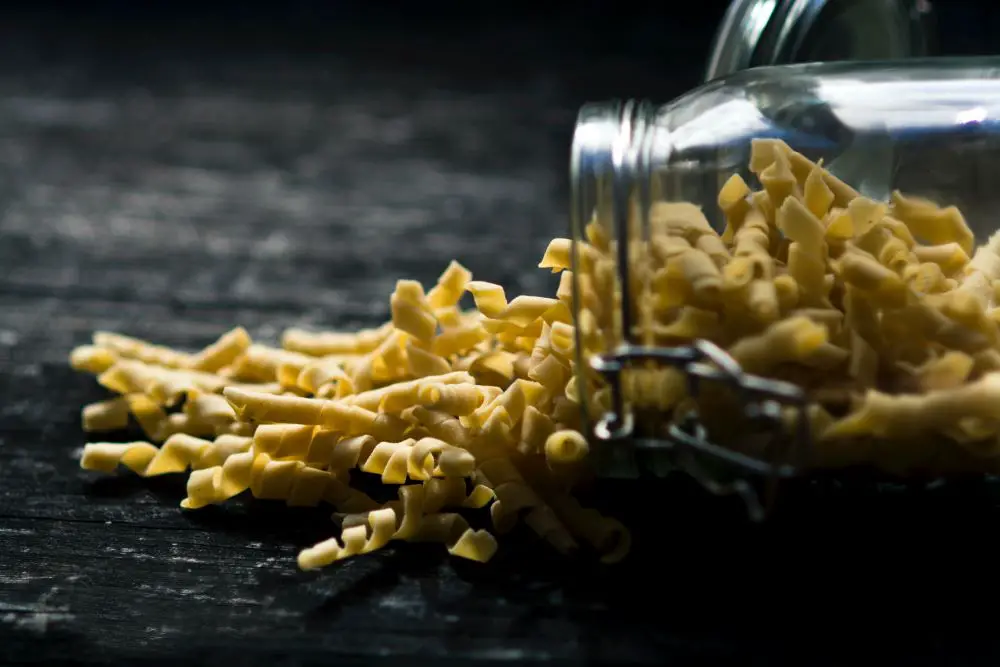
Once again, vegetables and particularly fruits need a bit of extra attention. It is good to condition these once they come out of the dehydrator. Conditioning means cooling them to room temperature and storing them loosely in an airtight glass jar for up to a week. If there are no signs of mold or moisture after regular inspection, you can pack and store them. If there are signs of moisture you can put them back in the dehydrator but any signs of mold you must get rid of the whole batch.
To store your dehydrated food, you need to be using airtight containers and storing them in a cool, dark and dry place but also somewhere that is well ventilated. There are additional methods you can go to to ensure your food doesn’t spoil, such as:
- Sanitizing your hands before touching the food
- Using vacuum containers to remove all the air completely
- Using oxygen absorber or desiccant packets in your storage area
Types of Dehydrators
Non-electric dehydrators
Sun Drying – It is possible to dehydrate food in the sun, which has been done for thousands of years. Although perhaps less accurate than using a machine, so long as the temperature is at 86 degrees Fahrenheit or about and the humidity about 60%, then you can give it a try.
Solar Drying – This method again uses the sun but is done by placing the food inside an enclosure. The sun warms the enclosure and indirectly dries the food. You can make your own enclosure or see below for our recommendations to buy one.
Electric dehydrators
Electric dehydrators allow you to dehydrate your food without relying on the weather. They use a heat element and fan to heat the food and circulate air evenly.
Features to Look for in Electric Dehydrators
Type of power used
Most electric dehydrators will be set up to use an AC power supply, so make sure you have an AC-DC adapter in place if you are generating your power through solar without and you don’t have an inverter. It is also worth checking out the power usage of the dehydrator to make sure your system can support it.
Power usage
The power usage of your dehydrator will vary according to which unit you choose. But it is worth thinking about how much of your power supply running a dehydrator will use, especially if you rely on stored power. Consider the power usage, how long it will run for and how much food it can hold at one time.
Capacity
This is how much tray space you will get in your dehydrator, usually measured in square feet. If you are growing your own and have a harvest that comes all at once, a larger capacity can be helpful. Some models have expandable tray space, so this might be a “best of both” solution.
Unit size
Unit size describes the actual size of the dehydrator. In some circumstances you might not need to worry about this much, but if you are living off-grid in your RV or boat, it will be really important!
Fan and Heat Element position
All electric dehydrators will have a heating element and a fan to provide the two essential processes of dehydration. However, the positions of these elements can vary and can make a difference too. Dehydrators that have the heating element and fan in the base of the unit take advantage of the natural effects of heat rising. This means the fan doesn’t have to work so hard to circulate the air, which is excellent for keeping your power usage low. But it does mean that sometimes juices from the food above it can drip into the heating element if it isn’t protected.
Siting the fan and heating element in the top of the unit means the fan has to work a little harder to circulate the area. This means it is more likely you will have to swap the trays around inside to ensure even dehydration.
The best solution, and one featured in most of the top-end dehydrators, is to have the heating element and fan at the back of the unit. This allows the air to blow through the middle of the trays, evenly distributing the heat.
Temperature control
Most models of dehydrator will allow you to set the temperature and this is pretty key to successfully dehydrating a range of foods.
Timer
This is a useful, although perhaps not an essential, feature. Many dehydrators will have a timer setting or option to automatically shut off once it has finished the set time. This can not only help you save on power costs but make sure foods don’t get too tough by being in longer than necessary.
Viewable chamber
Not all dehydrators have a glass or plastic panel in the front, but it can be helpful so you can see how close to being done your food is.
Included accessories – racks, sheets and mats
It is worth being aware that while some dehydrators come with racks, sheets and mats included, others do not. It is easy enough to get these separately, but it is worth bearing it in mind, especially if you are on a budget.
The Best Dehydrators for Off-Grid Living
This is our selection of the best dehydrators for use in off-grid homes:
Electric Dehydrators
OSTBA Food Dehydrator
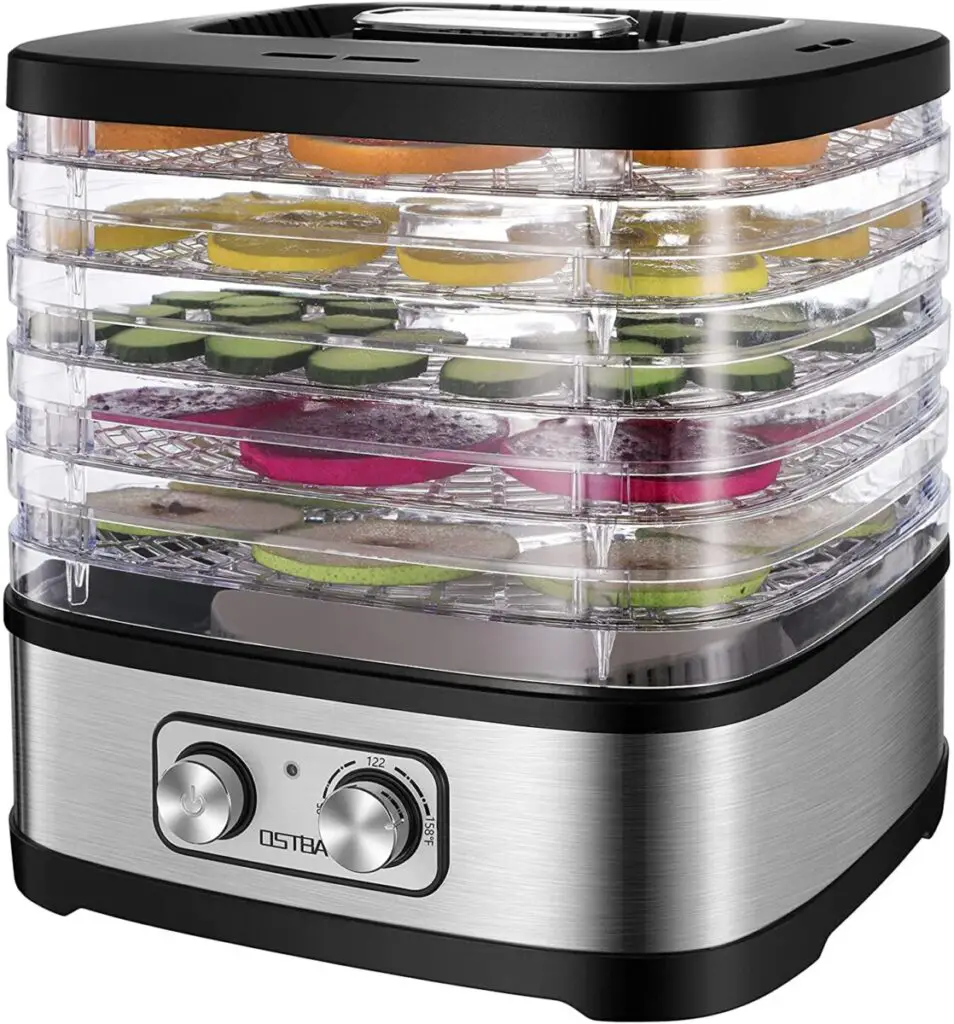
This dehydrator is one of the smaller models but still has the benefit of clear sides so you can see what is happening with your food. You won’t be able to dehydrate food in large batches with this unit but if you are concerned about your power usage it is a good option as it uses 240W. It doesn’t have the digital controls that the other models have but you can still adjust the temperature and time depending on the food you put in it. This model comes with 5 trays and you can adjust how closely they stack together by rotating them.
PROS –
- lowest power usage at 240W
- good for use if you have limited space at only 10 x 8 x 10 inches
- clear sides
CONS –
- manual controls only
- not the capacity of some of the other units
Buy Your OSTBA Dehydrator here
COSORI Premium Dehydrator
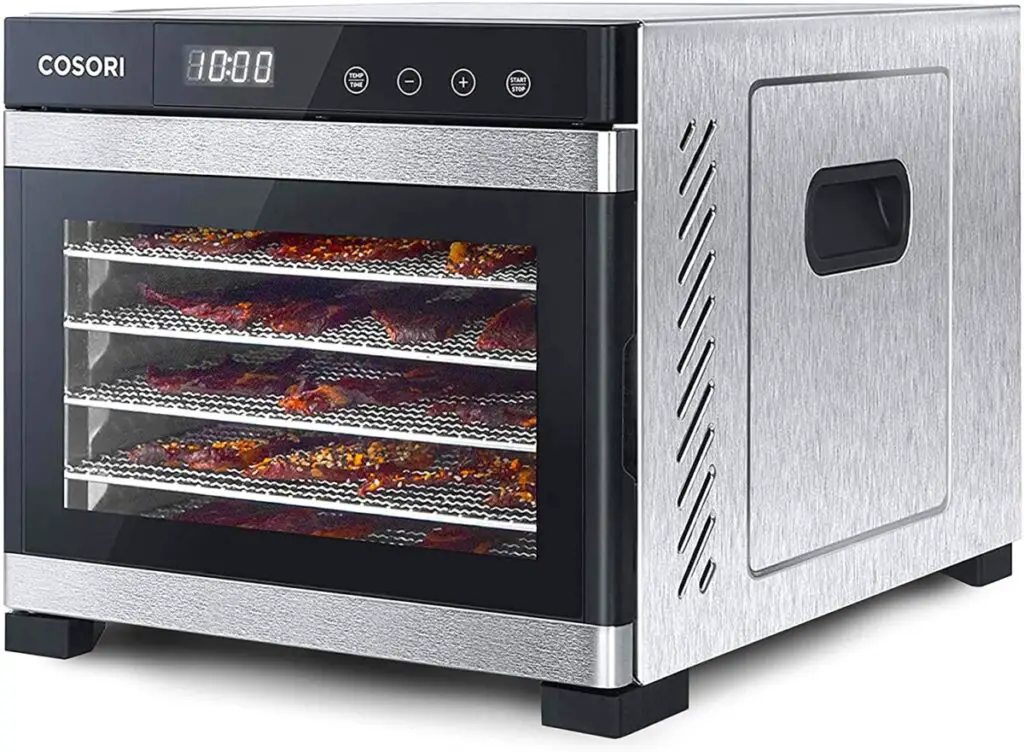
This dehydrator is easy to use and well made. The stainless steel unit and shelves, which are included, make it an upgrade from a plastic unit and simple to keep clean. The glass door means you can see what is going on inside and easily keep an eye on your food. The variable temperature settings mean you can adjust your dehydrator to best suit the food you are preserving. With the fan and heating element at the back of the unit, you can be sure of even heat and air distribution. However, this comes at a higher power usage of 600W.
PROS –
- Comes with accessories – 6 stainless steel trays, 1 mesh screen and 1 fruit roll sheet
- Made of food-grade stainless steel with glass front door
- Digital control with temperature and timer settings
- Fan and heating element at the back of the unit
- Auto shut off
CONS –
- Not the smallest model at 13.4 x 17.8 x 12.4 inches, so it might not suit an RV or boat
- A higher power usage at 600V means you need to have a pretty steady power supply
Buy Your COSORI Dehydrator Here
Excalibur Electric Food Dehydrator
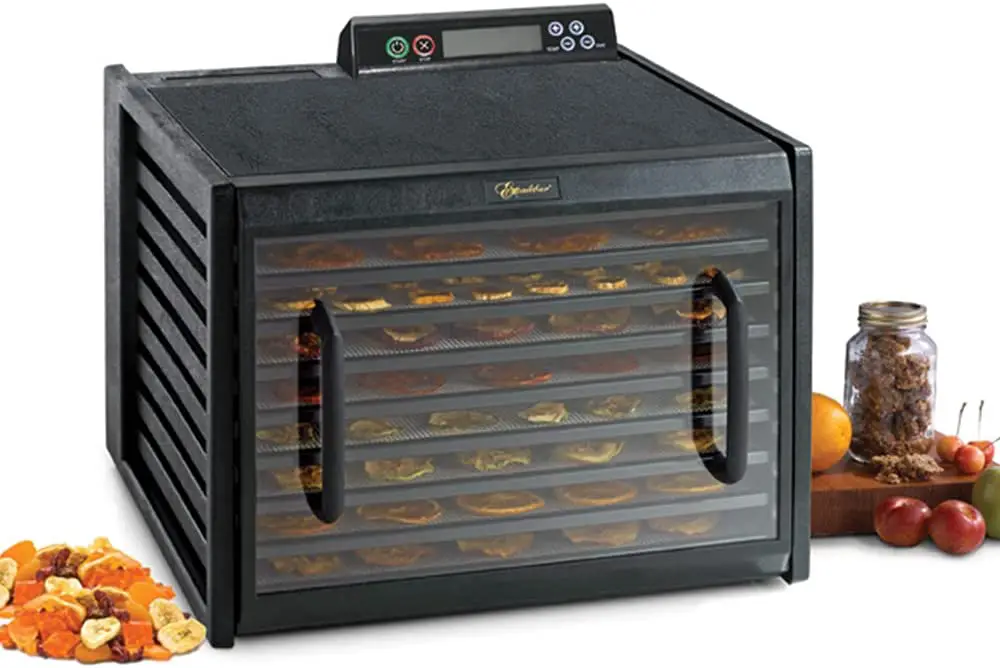
Excalibur dehydrators are often considered the best dehydrators you can get and they are worth considering if you want to do a lot of dehydrating. The one thing to remember though is that units like these need power. This one uses 600W. This model has huge capacity for dehydrating a lot of food in one go and with the airflow evenly distributed, you don’t need to rearrange your trays during the process. The range of temperature settings means you can tailor the process and the timer allows you to even run the unit overnight. Compared to previous Excalibur models, this unit has a transparent door which is a significant improvement. However, it can be noisy.
PROS –
- This model has capacity for 9 trays allowing for 15 square feet of drying space
- Airflow distributed evenly
- Clear door so you can monitor progress inside
- Digital control with temperature and two timer settings
CONS –
- Again, a larger unit at 19 x 17 x 14 inches, but that is due to large capacity inside
- A more expensive option but worth the investment if you are going to be doing a lot of dehydrating food
- Has a higher power usage
- Has been criticized for being a bit noisy
Buy Your Excalibur Dehydrator Here
COSORI Food Dehydrator
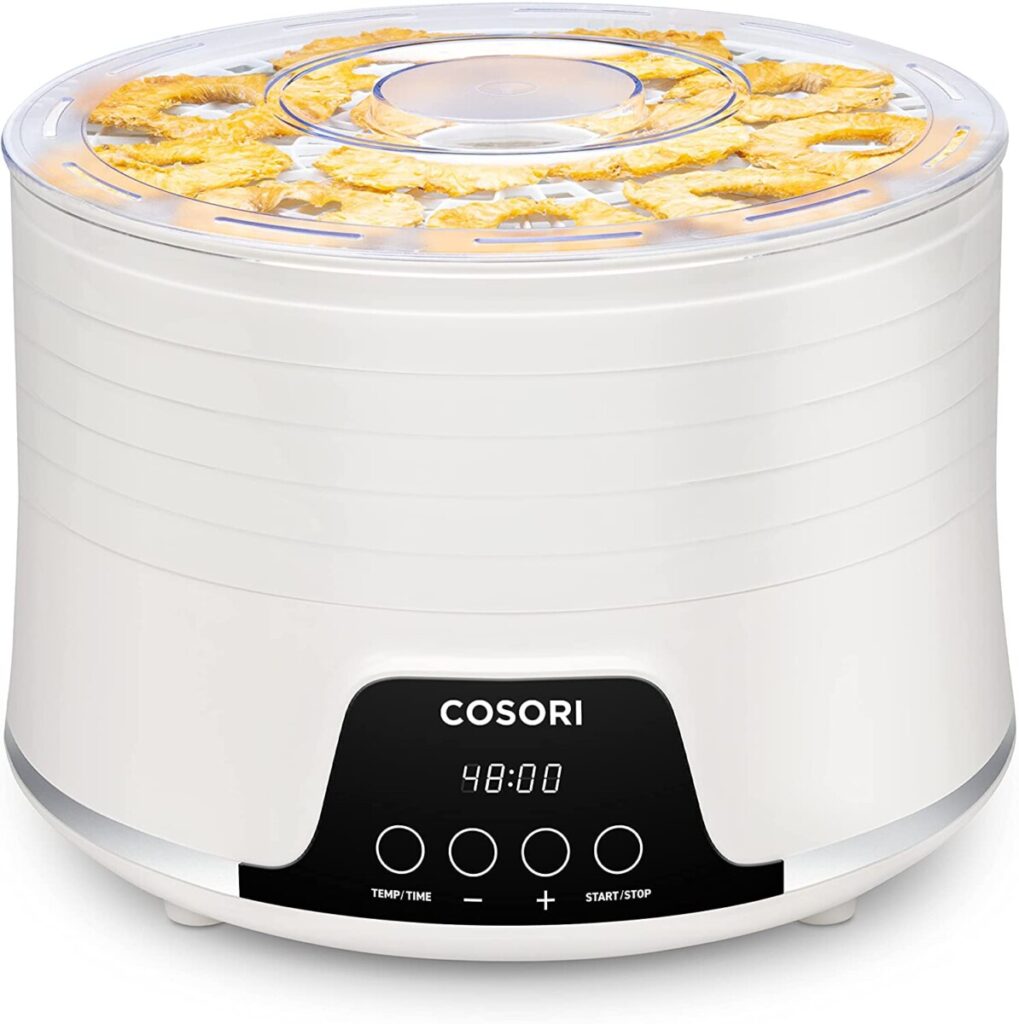
While only a plastic unit, this COSORI dehydrator is definitely worth considering, especially if you are wanting to try dehydration for the first time or if you want to keep your power usage low. It will easily fit on a small work surface and comes with five trays. It still has all the temperature and timer settings of some larger models and has been commended for how quiet it is.
PROS –
- A good budget option
- A lower power usage at 350W so better if you don’t have a steady power supply
- Small and compact at 12 x 12 x 9 inches
- Digital controls with temperature and timer settings
- Quiet when running
CONS –
- The smaller size does mean you can’t fit as much food in at a time as some of the other models
- Heating element and fan is in the base of the unit, but there haven’t been any complaints of uneven dehydration
Buy Your COSORI Dehydrator Here
NESCO FD-79 Snackmaster
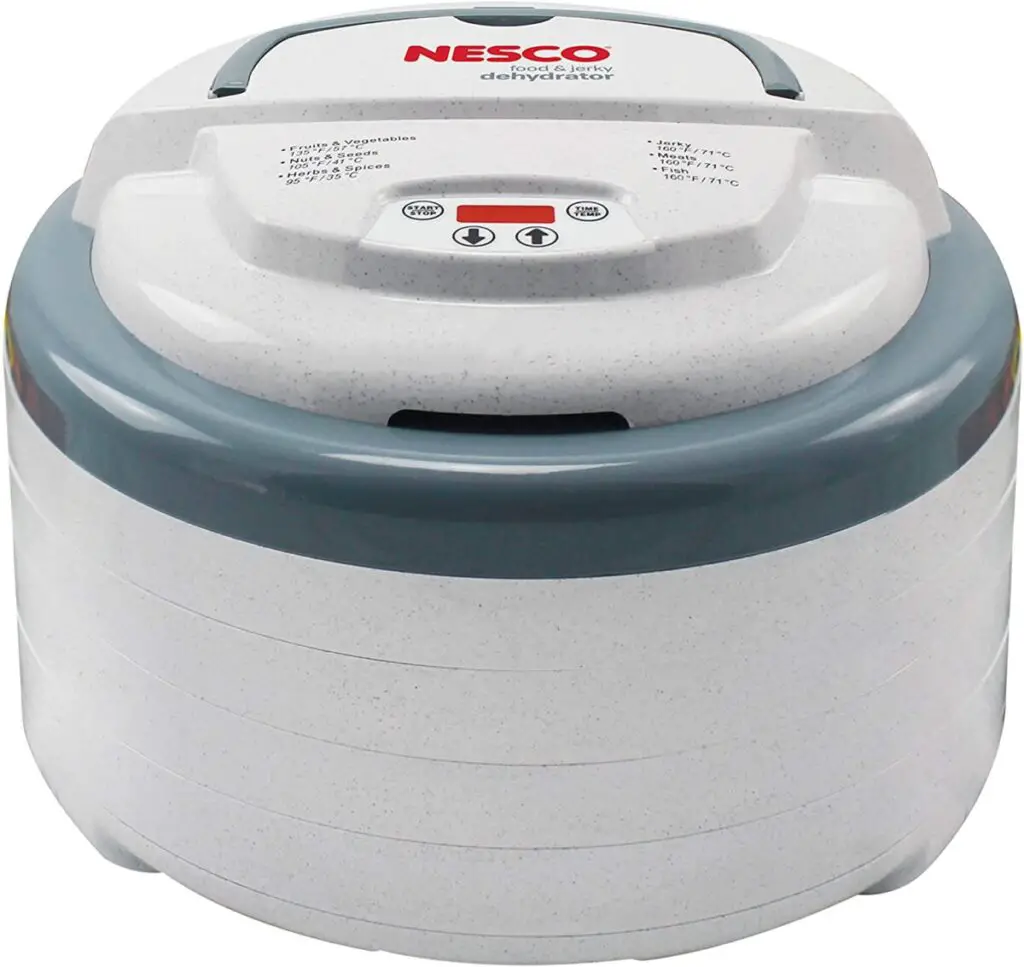
Once again, another plastic unit not to be dismissed if you don’t mind the higher power usage. This unit is excellent for a small space and can expand from the 4 trays it comes with to 12 trays. This allows for a lot of food to be dehydrated in a small space! The fan is located in the top of the unit, but it is still quiet when running and offers the temperature range and timer settings comparable with other models.
PROS –
- Fairly small unit, so a good option if you have limited space. Dimensions are 13.5 x 13.5 x 10 inches
- Expandable – comes with 4 trays, but it can expand to accommodate 12 trays if you buy them separately. It also comes with 2 fruit roll sheets.
- Quiet when running
- Adjustable time and temperature control
CONS –
- Made of plastic so not quite as good as those made from stainless steel
- Higher power usage at 600W
- There is no viewable chamber on this unit, so you can’t see what is going in inside
Buy Your NESCO Dehydrator Here
Magic Mill Food Dehydrator Machine
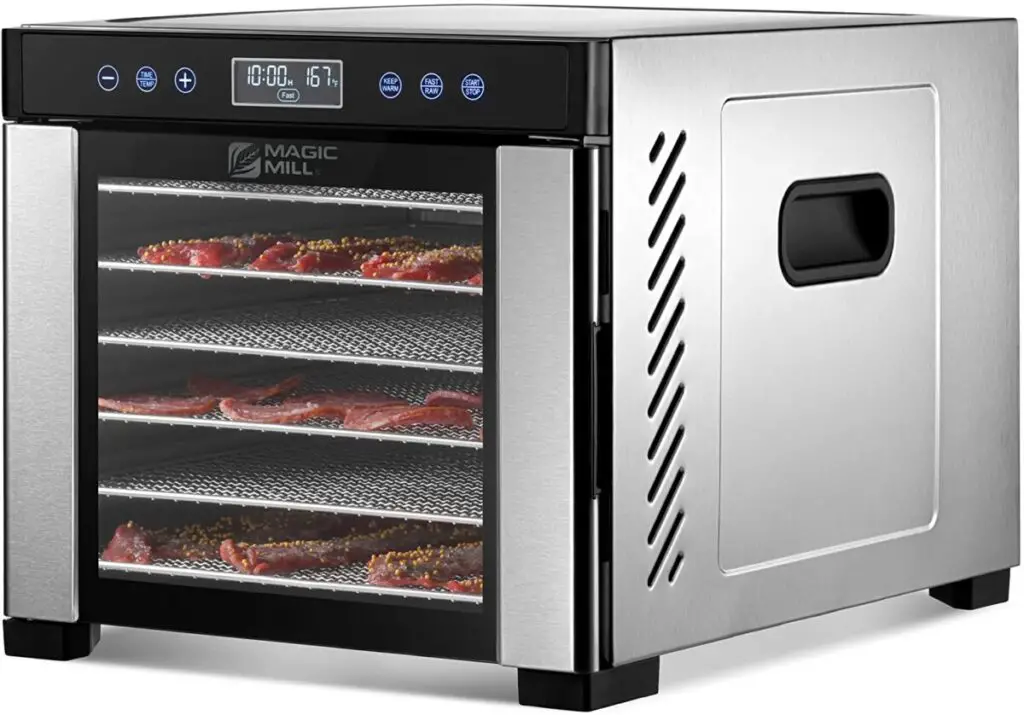
A medium-sized, stainless steel unit offering good capacity for dehydrating food at the same time but does use more power to do it. This dehydrator comes with 7 stainless steel trays, 2 mesh sheets, 2 non-stick trays and gloves. It has the option to set both temperature and timer according to what food you are dehydrating and the clear door allows you to see inside.
PROS –
- Rear-mounted heating element and fan for even distribution of heat and air
- Digital thermostat and timer with auto shut-off
- Comes with accessories
- Transparent door window so you can see all the trays inside
CONS –
- The size, although not the largest, might be too big for some worktops at 15 x 13.5 x 19 inches
- Power usage is 600W
Buy Your Magic Mill Dehydrator Here
Non-Electric Dehydrators
Herb Drying Rack Food Dehydrator
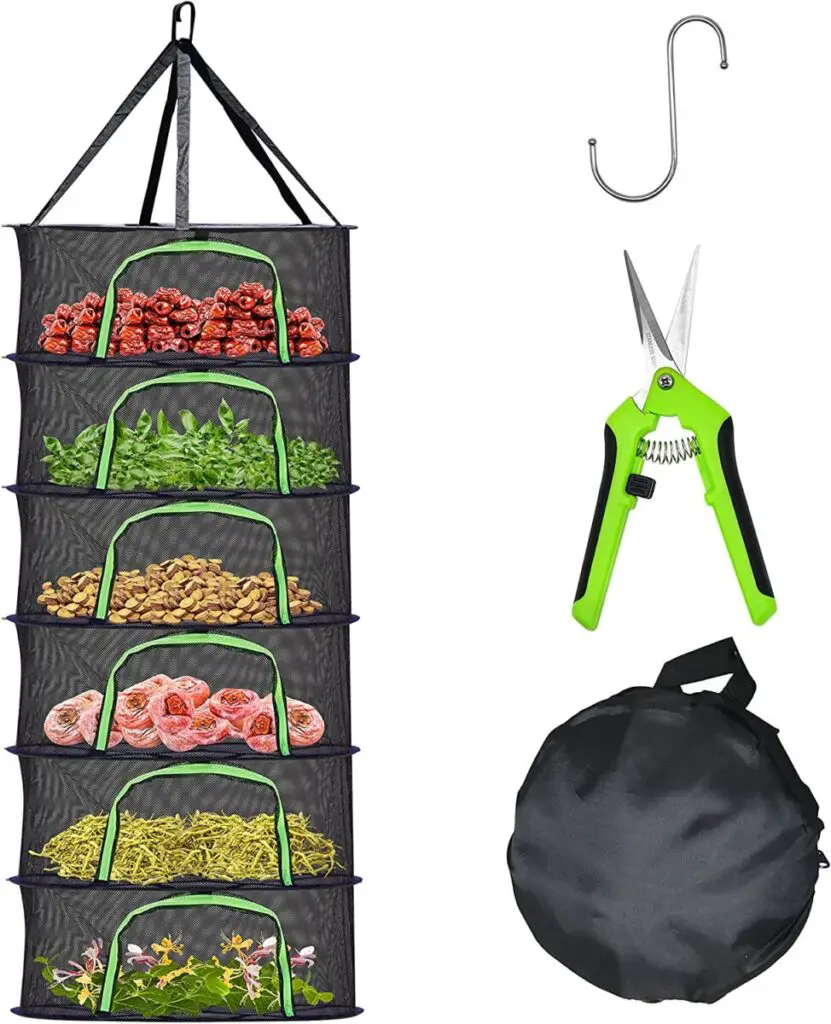
If you want to try dehydrating food without using an electric dehydrator then this drying rack has everything you need. Best for drying herbs, fruits or vegetables the 6 tiers offer decent space for hanging foods outside. The rack is portable and easily stored, collapsing down to just 3 inches thick.
PROS –
- A 6 tier pop up drying rack
- Best for attempting dehydration from sun drying
- Comes with shears and a hanging hook
- Good to try drying herbs and other fruit and vegetables outside
CONS –
- Uses a less reliable method for drying
- Not recommended for drying meats
Buy Your Herb Drying Rack Here
Summary
Dehydration is a good method of preserving food to give variety to your store cupboard. When living off-grid that can also save you space and help prevent wasting homegrown harvests. To successfully dehydrate suitable foods, you need to evenly heat the food and draw off the moisture with a regular flow of air. Electric dehydrators allow you to set the time and temperature for your food to dehydrate. Once dehydrated, food can be stored for months, even up to a year, so long as it is kept in an airtight container and stored in a cool, dark and well-ventilated place.
Related Reading
If you’re looking for tools, equipment or reading materials, I have some other articles that you may find useful:
- Best solar power equipment recommendations
- Water supply and plumbing
- Power tool recommendations
- Best hand tools
- Useful gadgets and tech
- Best books for learning how to live off-grid
My Off-Grid Product Recommendations
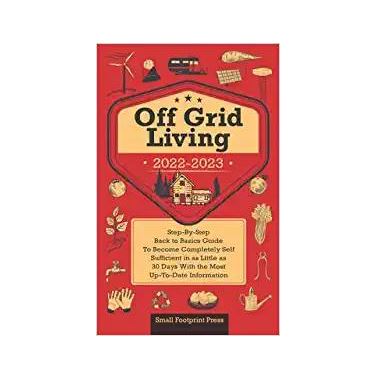
Useful Book: Off Grid Living 2022-2021 – This incredible step by step guide is a great read and gives you useful information about reaching self-sufficiency in just 30 days. Get the paperback on Amazon or read it free with a Kindle Unlimited subscription or listen to the audio version with Audible Plus membership.
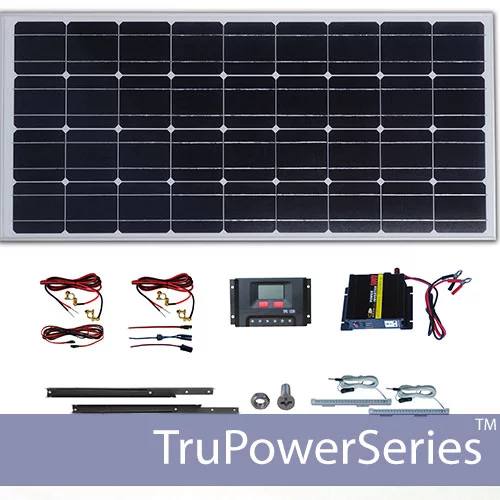
Small Solar Panel Systems: Silicon Solar – This is an excellent company that offers lots of products to get you started on your solar journey. Visit Silicon Solar.
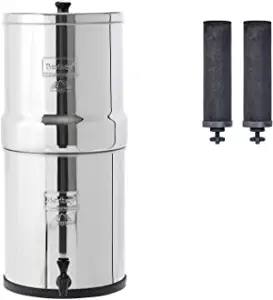
Family Water Filter: Big Berkey – For a fast, affordable water filter with no plumbing required, you can’t beat a Big Berkey gravity-fed filter like this one from Amazon.
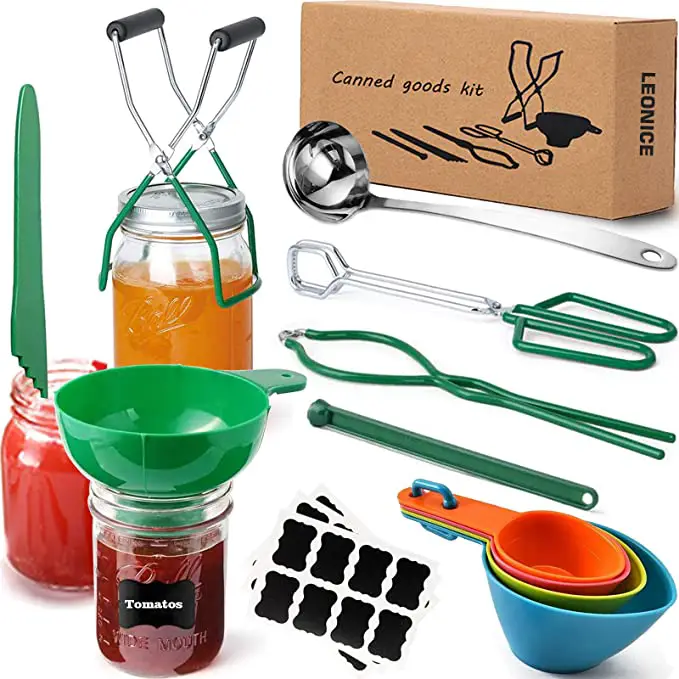
Canning Equipment – This canning starter kit, 22-quart Barton pressure canner and twelve-pack of Ball 16oz mason jars will help you preserve food as you work towards self-sufficiency.
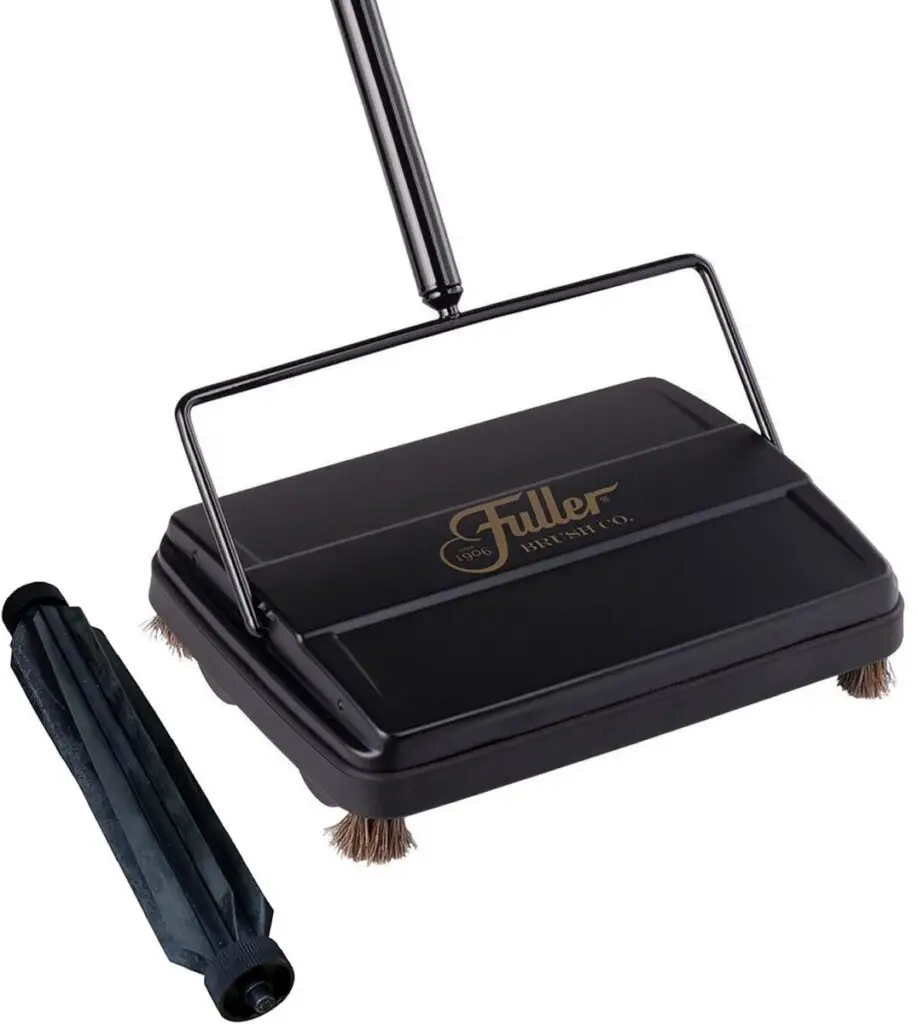
Cleaning: Fuller Carpet Sweeper –. This carpet sweeper is an ideal way to keep your home clean without using up your energy stores on vacuuming.

Handy Knife: Gerber Serrated Paraframe – This handy all-purpose knife is lightweight and ideal for all those little jobs around your home and garden.
